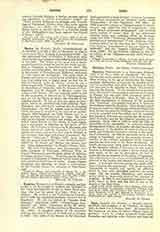

Canice (or KENNY), Saint, commemorated on October 11, b. in 515 or 516, at Glengiven, in what is now County Derry, Ireland; d. at Aghaboe in 600. He was descended from Ui-Dalainn, a Waterford tribe which dwelt on an island now identified as Inis-Doimhle in the Suir. The father of the saint was a distinguished bard who found his way to the North and settled at Glengiven in Cinachta under its chief. His mother was called Maul; her name is commemorated in the church of Thomplamaul, Kilkenny, dedicated to God under her invocation. The early years of Canice were spent in watching his chieftain’s flocks, but, God calling him to higher aims, we find him in 543 at Clonard, under St. Finian, where he was a fellow-pupil of St. Columba. In 544 he was studying in the school of Glasnevin, with St. Kieran of Clonmacnoise and St. Comgall of Bangor, under the tuition of St. Mobhi. He was ordained priest in 545 in the monastery of Llancarvan in Glamorganshire, and set out for Rome to obtain the blessing of the reigning pontiff. In 550 we find him again at Glen-given, where he converted his foster-brother, Geal-Breagach, who afterwards assisted him in founding Drumachose. In 565 he passed over to Scotland, where his name is recalled in the ruins of an ancient church, Kil-Chainnech on Tiree Island, and in a burial ground, Kil-Chainnech, in Iona. He built cells on the islands of Ibdon and Eninis, an oratory called Lagan-Kenny on the shores of Loch Lagan, and a monastery in Fifeshire on the banks of the Eden. He is known in Scotland as St. Kenneth, was closely associated with St. Columba in the latter’s missionary work, and, next to him and St. Bridget, is the favorite Irish saint in Scotland (Eammack). See Reeve’s “Adamnan” (Dublin, 1857, xxvi, xxxi); also the ancient lives in the “Codex Solmanticensis” edited by De Smedt and Backer (see below), and the “Liber Kilkenniensis” in Marsh’s Library, Dublin. His Irish foundations were Drumachose, two miles southeast of Limavady, Kilkenny West, in County Westmeath, and the great Abbey of Aghaboe in Ossory, Queens County. Tradition asserts that he founded a monastery in Kilkenny by the round tower and cathedral which bear his name. A man of great eloquence and learning, he wrote a commentary on the Gospels, known for centuries as Glas-Chainnigh.
MICHAEL M. O’KANE

